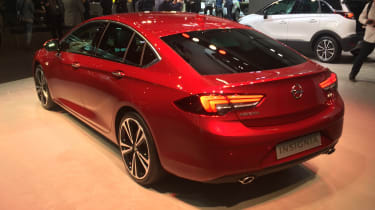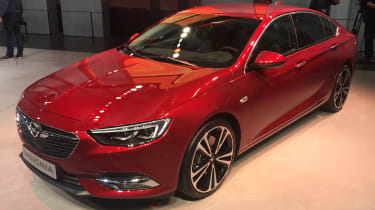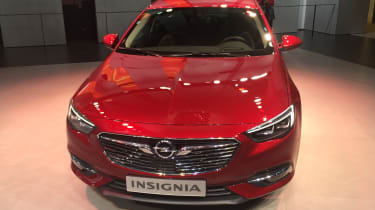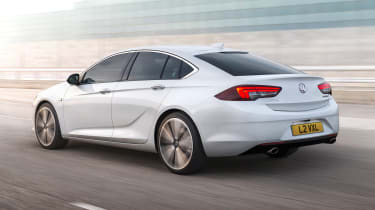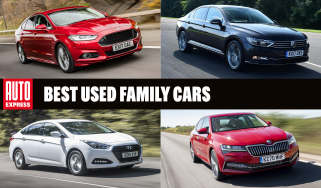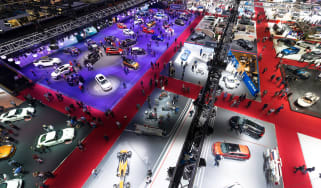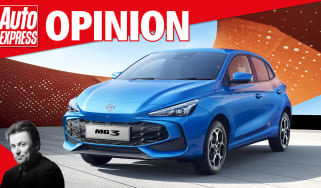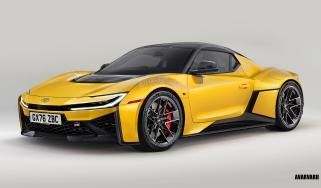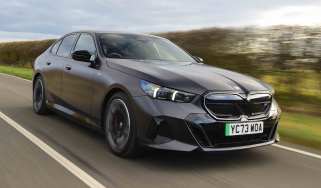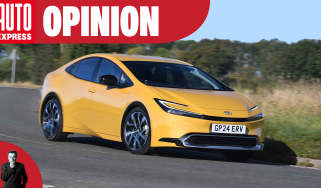New 2017 Vauxhall Insignia Grand Sport: prices and specs
Vauxhall's Insignia gets plusher interior and a tweaked name ahead of arriving on UK roads this summer
Vauxhall's Insignia Grand Sport is the firm’s new Skoda Superb fighter. The firm claims it is a more upmarket offering than the Insignia model it replaces, swooping in with a more four-door coupe-biased look and the ‘Grand Sport’ addition to its name.
On sale now, it’ll arrive on UK roads this summer. Prices for the Insignia Grand Sport start at £17,115 – that’ll get buyers a 1.5-litre turbo petrol engine with 138bhp. The range will stretch right up to a 256bhp 2.0-litre turbo petrol, which in range topping trim will be priced from £27,710. Diesel engines are available too.
• Geneva Motor Show 2017 as it happens
The popularity of cars like the Insigna – alongside its age-old rival, the Ford Mondeo – has been squeezed considerably by the ever growing popularity of SUVs and crossovers, plus aggressive finance offers on more premium saloons from upmarket German manufacturers. To this end, Vauxhall is countering with a more spacious, sophisticated and tech laden offering bearing a new name: Insignia Grand Sport.
Vauxhall Insignia Grand Sport: design and practicality
The overall looks of the new car take significant cues from the Monza Concept that was first seen at the Frankfurt Motor Show back in 2013. The front end gets slim headlights and a more vertical grille that’s mounted lower than on the outgoing model. At the side is what Vauxhall calls a ‘sweepspear’ – in effect, a deep crease that starts low down near the sill and moves up just before the rear wheelarch – while the rear features split tail-lamps and an LED third brake light integrated at the top of the glass.
The five-door version of the car gets a much longer wheelbase – increased by 92mm – although shortened overhangs mean that the car isn’t much longer overall. Its roofline does sit lower, though, giving it what Vauxhall hopes is a coupe-like look; this, combined with styling cues designed to make the Insignia appear wider, provides it with a more aggressive stance.
That growth in wheelbase is designed to make the Insignia’s rear cabin as spacious as a Superb’s, and more roomy than any of the premium executive models’. And while the roofline has been lowered, so has the seating position – to the point where Vauxhall claims there is actually more headroom in the rear seats than before.
“You sit in the driver’s seat of the new Insignia, whereas you sit on the driving seat of the outgoing model; I think that’s a key difference,” Mark Adams, vice president of Opel/Vauxhall design, told us last year.
“In fact, moving the driver’s hip point down allowed us to lower the roofline to give that coupe-like profile, and make a car that is barely any wider than the one it replaces look quite a bit wider to the eye.”
Boot capacity, meanwhile, is a decent 490 litres, rising to 1,450 litres with the split rear seats folded down. Those figures are some way shy of the Superb’s 625 litres and 1,760 litres, but slightly up on a 3 Series.
• New 2017 Vauxhall Insignia Sports Tourer estate
Despite the increase in size, the new Insignia is up to 175kg lighter than the car it replaces; this is because it switches to a platform that shares weight-saving principles with the latest Astra’s. As a result, Vauxhall claims that the revised engine line-up – comprising a mix of 1.5 and 2.0-litre turbocharged petrols and 1.6 and 2.0-litre turbodiesels – is able to deliver improved performance and fuel efficiency.
Vauxhall Insignia Grand Sport: engines and prices
The 1.5-litre petrol engine serves as the entry-level motor, offered in 138bhp and 163bhp states of tune and mated to a six-speed manual gearbox. The other petrol offering is the range-topping 256bhp 2.0-litre turbo, which comes with an eight-speed automatic gearbox driving an all-wheel-drive system. This engine be available on Elite Nav cars and up, priced from £27,710.
The entry-level diesel is covered by a 1.6-litre turbo with 109bhp, priced from £18,485 and producing 105g/km CO2. The same powerunit can be had with 134bhp. The range-topping diesel is a 2.0-litre turbo unit, priced from £21,715.
With these six engine choices, the launch line-up is huge and comprises of seven different trim levels: Design, Design Nav, SRi, SRi Nav, SRi VX-Line Nav, Tech Line Nav and Elite Nav versions of the car with different equipment levels will be available.
On the four-wheel-drive chassis, there is a pair of multi-plate clutches instead of a rear differential – a similar system in design to the Ford Focus RS’s, and one that allows the Insignia to be offered with torque vectoring. As well as feeding power to the wheel with the best traction in snow, the set-up will prioritise the outside rear wheel in corners to help the car to turn in more crisply.
Vauxhall calls the intelligent torque distribution "yaw damping", and drivers will be able to choose the amount of yaw damping to suit their driving style through two settings: "Tour" and "Sport".
Vauxhall Insignia Grand Sport: infotainment and tech
Inside, the Insignia’s dashboard gets a sorely needed workover, with a large infotainment screen replacing the plethora of buttons on the current facia. Adams added: “We’ve focused on horizontal lines to make the dashboard look as wide as possible, and we’ve worked very hard on reducing the number of buttons, because I know we’ve been criticised for that.”
It houses Vauxhall’s latest IntelliLink software and OnStar services, including an on-call concierge. Smartphone connectivity is incorporated, with Apple CarPlay and Android Auto. Adams told us: “We’ve tried to keep functionality; it can be hard to stab the right bit of a touchscreen if you’re travelling on a poorly surfaced road. So we’ve designed in a small shelf in front of the display that will help you to steady your hand as you operate the screen. We think little touches like that can make a big difference.”
Other features fresh to the Insignia include a new generation of Vauxhall’s IntelliLux LED matrix lights, which can focus the beam when going around corners and provide up to 400 metres of illumination. New safety kit includes rear cross traffic alert to help when reversing out of a space or driveway, plus adaptive cruise control.
There will also be an estate version of the car, called the Insignia Grand Tourer. It’s likely to arrive in UK dealers a couple of months after the hatchback, in late summer 2017. Adams told us the cars were designed alongside each other, allowing the team to fix key points of the side profiles and ensure they progressed smoothly through to both hatchback and estate rears.
Further down the line, the firm is likely to offer a jacked-up, off-road-style version, but it’s still unclear whether the high-performance edition that’s also on the way will carry the VXR badge.
Vauxhall Insignia Q&A with Mark Adams
Vice president, Opel/Vauxhall design
Styling boss reveals all to Auto Express about the design process behind the striking new Insignia, and also gives us some clues about what the future may hold for the Vauxhall brand in terms of design.
Q: What was the overall target with the new Insignia?
A: “Firstly, we had to move on from the existing car, which I think still looks strong, despite the fact that it’s quite an old model now. Secondly, although we’re not trying to be premium, there’s no denying that we had to react somehow to the fact that a lot of the German brands have come down to the mainstream. We wanted to give Insignia customers more reasons not to migrate in that direction.
“And finally, we’ve been through a full revamp on the range; it was time to introduce what I call ‘Design 2.0’, showing where we’re going to go in the future.”

Q: How can you make the car more premium through design?
A: “In a few ways. There’s a key part of the profile – the space between the bottom of the windscreen [the A-pillar] and the front wheels – that we’ve changed. It’s usually a bigger gap in the German premium cars because they’re rear-wheel drive.
“The Insignia is still very much a front-wheel-drive car, but we tried to push the front wheels towards the front of the car, and the rear wheels towards the back, to change the proportions. Then there’s the front grille; it’s now so upright that it’s almost inverted, and we think this is strong, proud and confident.”
Q: What does the Insignia tell us about future Vauxhall design?
A: “I want our line-up to be coherent and consistent; I think if there’s one criticism that could be levelled at Vauxhall in the recent past, it’s that there was a lot of variation across the line-up.
“We have a large, diverse portfolio of products, and they have to appeal to lots of different people – but I’m not a fan of ‘Russian doll’ design. I use my family as an analogy; we have two children and they have a bit of me and my wife in them. You can see the DNA. But they’re not clones; that would be just a bit scary.”
What do you think of the new Vauxhall Insignia Grand Sport? Let us know below…

